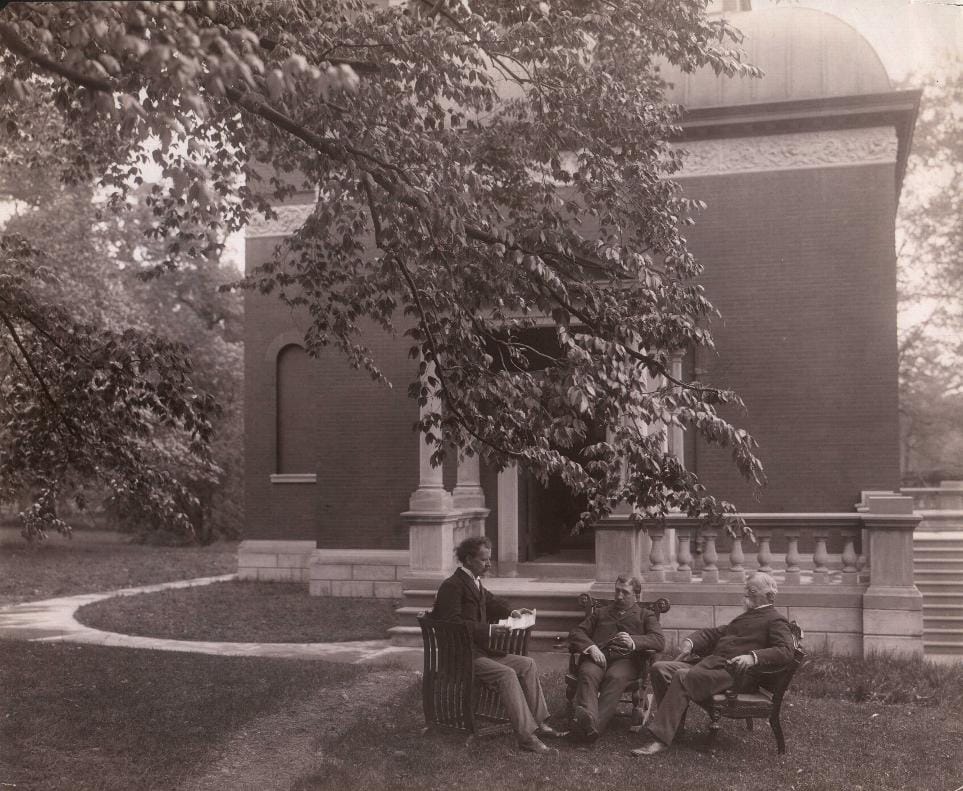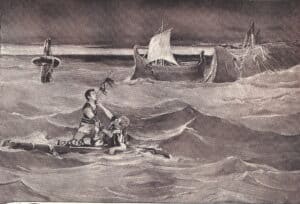
In March of 1898, Lew Wallace was quoted in the Crawfordsville Weekly Journal when it picked up a story printed in the Indianapolis Journal where the author declared: “Won’t Dramatize It. Gen. Wallace Tells Why He Won’t Have Ben-Hur Put on the Stage. “This evening,” said General Wallace, “I received a letter from a man in an Eastern city who wants to dramatize ‘Ben-Hur.’ I’ll have to write to him and tell him why it cannot be done. There are very good reasons why the story would not be successful as a drama. Those who have read Ben-Hur will recall that the story was written with reference to three different climaxes – the crucifixion, the battle on the water and the chariot race. In the first place I should never consent to allow the crucifixion portrayed on the stage, and one can see how impossible it would be to give, by any kind of stage effect, the chariot race and the battle of the galleys, so that they would be properly appreciated.”
This declaration by General Wallace proved premature as within a year he and his son Henry were negotiating for a stage production. By late 1899, Ben-Hur was on Broadway and quickly making both history and money. It was soon traveling across the United States and overseas. In November of 1902 it was booked for English’s Opera House on Monument Circle in Indianapolis for a two-week run. The play opened on November 24 and because of the sales success the run was extended. On November 25, the Indianapolis News reported that the production was starring William Farnum as Judah Ben-Hur and Basil Gill as Messala. The next day, the newspaper reported $20,000 in advanced ticket sales for the Indianapolis run. It was a smash hit.
During the Indianapolis run of the play prominent people attended and recorded their thoughts. Even the Bard of Alamo, James Buchanan Elmore saw the play and offered a quip or two. Various communities were highlighted on special nights. December 4 was Covington and Noblesville night while December 5 was Franklin and Crawfordsville night. According to the Indianapolis papers, “Covington people to the number of ninety, headed by County Superintendent George Hart, were in the city Wednesday to see “Ben-Hur.” “We would have brought 200 people over,” said Mr. Hart, “but we could not get tickets for that number for one performance. The best the box-office people would do for us was ninety seats and almost had a small riot in Covington to determine who should get them.”
When it was time for the Crawfordsville crowd the papers reported: “People from the Home of Ben-Hur See the Play Tuesday Night – Wabash Boys Make Noise. Crawfordsville did honor to its distinguished citizen, Gen. Wallace last night, and fully fifteen hundred people from that city crowded English’s to the doors at the performance of “Ben-Hur.
It was the intention of Gen. Wallace to witness the play last night but ill health kept him at his home, and it is probable that he will be unable to come to Indianapolis any time during the remainder of the engagement.
A more enthusiastic audience was never in English’s. The slightest pretense for applause was taken advantage of and the house fairly rang after the curtain fell upon the chariot race scene. The theater upstairs and down was packed with Crawfordsvillians and a number of them were compelled to purchase rush seats and standing room.
The special train over the Big Four, carrying eleven coaches, arrived at the Union station at 5:35 o’clock yesterday afternoon and left last night shortly before midnight. There were almost fifteen hundred people on the train, 100 of whom were Wabash college students, who made the Union station resound with their yells the minute they left the train. Their seats were scattered last night, and it was impossible to make a demonstration of any kind in the theater. James B. Elmore came in for his part of the students’ cheering.
Nearly the entire Crawfordsville chapter of the tribe of “Ben-Hur” were in the city and the special train was run under their auspices. The entire house for last night was engaged on the opening day of the sale of seats.”
Although Wallace had been under the weather on December 5, he did recover and was able to make a trip over to Indianapolis to see the play on December 19. The Crawfordsville Weekly Journal picked up a story by the Indianapolis Sentinel that Wallace attended a performance and took a special behind-the-scenes tour of the chariot race machinery. “Wallace at Ben-Hur. The General Sees the Inside Workings of the Chariot Race Machinery. General Lew Wallace witnessed Klaw & Erlanger’s production of the dramatization of his novel, “Ben-Hur,” from a box at English’s Friday afternoon. With him sat his son, Henry Wallace, and wife, and his two small grandchildren.
General Wallace, it was apparent, tried to keep out of sight of the audience as much as possible, and only a few were aware that the noted author of “Ben-Hur” was present. It is doubtful whether he would have responded with a talk had a call been made for him. The management of the production broke one of the ironclad rules of the company and invited General Wallace and his party to view the chariot race and several other of the scenes from the stage that he might see exactly how they are produced. The general was a very interested looker-on while the stage men were putting the machinery in place for the great chariot race scene. Stage Manager Rankin looked after the party while they were on the stage and introduced General Wallace to all the principal members of the cast. He chatted several minutes with Mr. Farnum, who has made a name for himself on account of his faithful presentation of “Ben-Hur.” The general was an interested spectator of the chariot race notwithstanding that this was the seventh or eighth time he has witnessed the production. Stage Carpenter Ayres and Master Machinist Lynch explained to him thoroughly the system by which such a realistic representation of the race is made. After the fifth act the party left the stage and resumed their seats in the box. General Wallace, it was evident, was pleased at the way the dramatization of his novel has been staged, and he made the remark afterward to Manager Towle that the production has now reached a stage of perfection. Mr. Towle acknowledged that there was a vast difference in the play as it is now and as it was when the first performance was given in New York City four years ago.”
Wallace had good reason to be pleased—not only because of the quality of the production, and international acclaim, but also because of the money the play was making for all involved. Just seven months later newspapers were reporting that receipts for the play were over $600,000 [the equivalent of over $22,000,000 in 2025 dollars—an exceptional sum for a play at the turn of the 20th century] in just 37 months. It was a success in New York, across the United States, in England and in Australia—even though the Australian production had to close for a time because of an outbreak of the plague and because on Palm Sunday 1902 the theater burned to the ground destroying the chariot machinery, costumes, and sets!
The Bard of Alamo wrote a lengthy poem about Ben-Hur after enjoying the play at English’s Opera House and his closing stanza summed up the public opinion of the entertainment.
